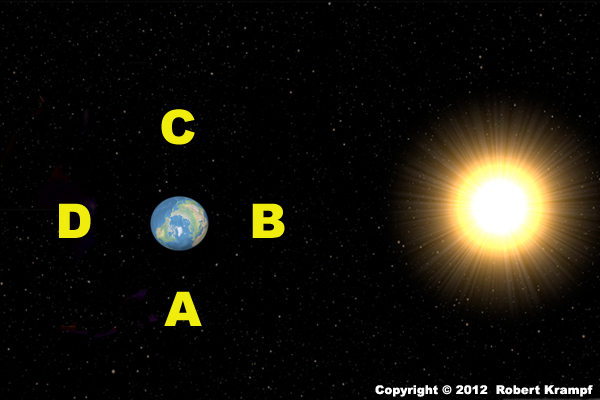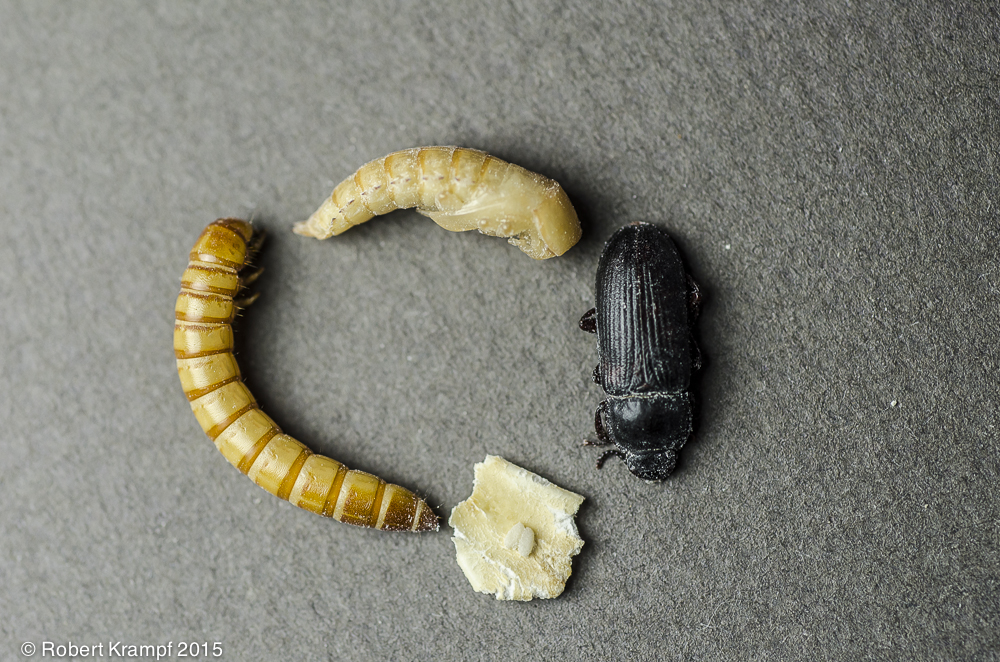Here are some science questions to help you test your general science knowledge. They will also show you which of the Florida, Utah, and NGSS science standards each question is testing.
The questions are chosen randomly, so this quest will be different each time.
Get 5 more random questions.
Would you rather see the most recently added questions?

Which position would the Moon be in during an eclipse of the Moon?
-
A
No. In this position, the Moon would not be in the Earth's shadow. -
B
No. In this position, the Moon would not be in the Earth's shadow. -
C
No. In this position, the Moon would not be in the Earth's shadow. -
D
Yes. In this position, the Moon could be in the Earth's shadow. It does not always pass through the shadow, so we don't have an eclipse every month, but when it does, it will be in this position.
Click to see which state standards this question tests, and which of my videos, experiments, and other resources support that topic.
Florida
SC.4.E.5.2 Describe the changes in the observable shape of the moon over the course of about a month.
| Why is a Full Moon So Bright? | text page, free, checked |
| Review Space-6 | practice |
| Review Space-7 | practice |
| Review Space-9 | practice |
Utah
UT.3.I.1.b Explain that the sun is the source of light that lights the moon.
| Why is a Full Moon So Bright? | text page, free, checked |
| Review Space-6 | practice |
| Review Space-7 | practice |
| Review Space-9 | practice |
UT.6.I.1.a Describe changes in the appearance of the moon during a month.
| Why is a Full Moon So Bright? | text page, free, checked |
| Review Space-6 | practice |
| Review Space-7 | practice |
| Review Space-9 | practice |
NGSS
MS-ESS1-1 Develop and use a model of the Earth-sun-moon system to describe the cyclic patterns of lunar phases, eclipses of the sun and moon, and seasons.
| Global Science | video, ClosedCaptions |
| Why is a Full Moon So Bright? | text page, free, checked |
| Review Space-9 | practice |
| Review Space-12 | practice |
| Review Space-6 | practice |
| Review Space-7 | practice |

The rattle on a Rattlesnake is an adaptation that:
-
attracts a mate.
No. Snakes do not hear airborne sounds, so another snake would not hear the rattle. -
attracts mice and other prey animals.
No. Like other animals, mice would be frightened away by the rattle. -
warns predators to stay away.
Yes! The sound of a Rattlesnake's rattle is a warning that the snake will bite to defend itself. -
helps the snake hide.
No. There is nothing about the rattle that would serve as camouflage or help the snake hide.
Click to see which state standards this question tests, and which of my videos, experiments, and other resources support that topic.
Florida
SC.5.L.17.1 Compare and contrast adaptations displayed by animals and plants that enable them to survive in different environments such as life cycles variations, animal behaviors and physical characteristics.
| Seed Search | video, ClosedCaptions, checked |
| Flowers | video, ClosedCaptions |
| Onion Crystals | video |
| A Walk in the Park | video, checked |
| Nature Watching | video, checked |
| Calling a Woodpecker | video, checked |
| Selective Smelling | video, checked |
| Review Plants-1 | practice |
| Review Adaptation-2 | practice |
| Review Adaptation-3 | practice |
| Review Adaptation-4 | practice |
| Review Adaptation-5 | practice |
| Review Adaptation-6 | practice |
Utah
UT.4.V.4.d Compare the structure and behavior of Utah amphibians and reptiles.
| A Walk in the Park | video, checked |
| Nature Watching | video, checked |
| Review Adaptation-2 | practice |
UT.7.IV.2.a Predict why certain traits (e.g., structure of teeth, body structure, coloration) are more likely to offer an advantage for survival of an organism.
| Onion Crystals | video |
| Selective Smelling | video, checked |
| Who Evolved on First? | text page, free, checked |
| Thoughts on an Exoskeleton | text page, free |
| Review Adaptation-1 | practice |
| Review Adaptation-2 | practice |
| Review Adaptation-5 | practice |
| Review Adaptation-6 | practice |
NGSS

How hot does an area have to be to be classified as a desert?
Answer:
Deserts are defined by lack of precipitation, not by temperature. They are areas where precipitation minus evaporation yields less than 10 inches of rain per year. The largest desert on Earth is in Antarctica, a very cold place.
Click to see which state standards this question tests, and which of my videos, experiments, and other resources support that topic.
Florida
SC.5.E.7.6 Describe characteristics (temperature and precipitation) of different climate zones as they relate to latitude, elevation, and proximity to bodies of water.
| Weather and Climate | video |
| Review Weather-7 | practice |
| Review Weather-9 | practice |
Utah
UT.4.V.1.c Locate examples of areas that have characteristics of wetlands, forests, or deserts in Utah.
| Review Weather-7 | practice |
| Review Weather-9 | practice |
NGSS

These are the four stages of a mealworm's life cycle. What kind of life cycle is it?
-
Incomplete metamorphosis
No. For an incomplete metamorphosis, there are only three stages: egg, larva, and adult. The young also look very similar to the adults. The mealworm larva looks very different from the beetle. -
Complete metamorphosis.
Yes! For a complete metamorphosis, the animal goes through four stages: egg, larva, pupa, and adult. -
Full metamorphosis.
No. There is no life cycle called full metamorphosis. -
Partial metamorphosis.
No. There is no life cycle called partial metamorphosis.
Click to see which state standards this question tests, and which of my videos, experiments, and other resources support that topic.
Florida
SC.2.L.16.1 Observe and describe major stages in the life cycles of plants and animals, including beans and butterflies.
| Seed Search | video, ClosedCaptions, checked |
| Review Life Cycle-1 | practice |
| Review Life Cycle-2 | practice |
| Review Life Cycle-3 | practice |
| Review Life Cycle-4 | practice |
SC.4.L.16.4 Compare and contrast the major stages in the life cycles of Florida plants and animals, such as those that undergo incomplete and complete metamorphosis, and flowering and nonflowering seedbearing
plants.
| Orange Slices | video, ClosedCaptions |
| Creating a Sprout Guide | text page, photography, free |
| Review Plants-4 | practice |
| Review Life Cycle-3 | practice |
| Review Life Cycle-4 | practice |
| Review Life Cycle-1 | practice |
| Review Life Cycle-2 | practice |
Utah
UT.5.V.1.c Compare various examples of offspring that do not initially resemble the parent organism but mature to become similar to the parent organism (e.g., mealworms and darkling beetles, tadpoles and frogs, seedlings and vegetables, caterpillars and butterflies).
| Review Life Cycle-1 | practice |
| Review Life Cycle-2 | practice |
| Review Life Cycle-3 | practice |
| Review Life Cycle-4 | practice |
NGSS
1-LS3-1 Make observations to construct an evidence-based account that young plants and animals are like, but not exactly like, their parents.
| Review Life Cycle-1 | practice |
| Review Life Cycle-2 | practice |
| Review Life Cycle-3 | practice |
3-LS1-1 Develop models to describe that organisms have unique and diverse life cycles but all have in common birth, growth, reproduction, and death.
| Review Life Cycle-1 | practice |
| Review Life Cycle-2 | practice |
| Review Life Cycle-3 | practice |

I poured some water on this rock. Later that day, the water was all gone. What happened to it?
-
It evaporated.
Yes. When liquid water turns into water vapor, the process is called evaporation. That is what happened to the water on the rock. -
It sublimated.
No. Sublimation is when a solid turns directly into a gas. Dry ice (frozen carbon dioxide) is an example of sublimation. The solid changes directly into carbon dioxide gas, without becoming a liquid. -
It condensed.
No. Condensation is when a gas turns into a liquid. The drops of water that form on the outside of a glass of ice is the result of condensation. -
It precipitated.
No. In weather, precipitation is when solid or liquid water falls from the clouds. Rain, snow, and sleet are examples of precipitation.
Click to see which state standards this question tests, and which of my videos, experiments, and other resources support that topic.
Florida
SC.3.P.9.1 Describe the changes water undergoes when it changes state through heating and cooling by using familiar scientific terms such as melting, freezing, boiling, evaporation, and condensation.
| Photographing Snowflakes | video, checked |
| Ice Cream Science | video, checked |
| Cloud Formation, part 1 | video, ClosedCaptions, checked |
| The Water Cycle | video, checked |
| A Model of the Water Cycle | video, ClosedCaptions, checked |
| Cloud Formation, part 2 | video |
| Making a Solar Still | video |
| Wonderful Water | video, checked |
| A Watched Pot | video |
| Why We Sweat | video, checked |
| What Really Happens With Evaporation? | text page, free, checked |
| Review Weather-1 | practice |
| Review Weather-2 | practice |
| Review Weather-10 | practice |
SC.5.E.7.1 Create a model to explain the parts of the water cycle. Water can be a gas, a liquid, or a solid and can go back and forth from one state to another.
>>> Teacher Page: Water Cycle
| A Model of the Water Cycle | video, ClosedCaptions, checked |
| Cloud Formation, part 2 | video |
| Cloud Types | video |
| Making a Solar Still | video |
| A Watched Pot | video |
| Photographing Snowflakes | video, checked |
| The Water Cycle | video, checked |
| Review Weather-1 | practice |
| Review Weather-2 | practice |
| Review Weather-8 | practice |
| Review Weather-10 | practice |
Utah
UT.4.I.2.a Locate examples of evaporation and condensation in the water cycle (e.g., water evaporates when heated and clouds or dew forms when vapor is cooled).
| A Model of the Water Cycle | video, ClosedCaptions, checked |
| Cloud Types | video |
| Making a Solar Still | video |
| A Watched Pot | video |
| Cloud Formation, part 1 | video, ClosedCaptions, checked |
| The Water Cycle | video, checked |
| A Cool Experiment | text page |
| Review Weather-1 | practice |
| Review Weather-2 | practice |
NGSS
MS-ESS2-5 Collect data to provide evidence for how the motions and complex interactions of air masses results in changes in weather conditions.
| Cloud Types | video |
| Nephoscope | video, checked |
| Cloud Formation, part 1 | video, ClosedCaptions, checked |
| Pine Cone Weather | text page, free |
| Review Weather-1 | practice |
| Review Weather-2 | practice |
| Review Weather-6 | practice |
| Review Weather-4 | practice |
| Review Weather-3 | practice |
The questions are chosen randomly, so this quest will be different each time.
